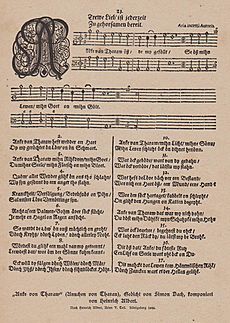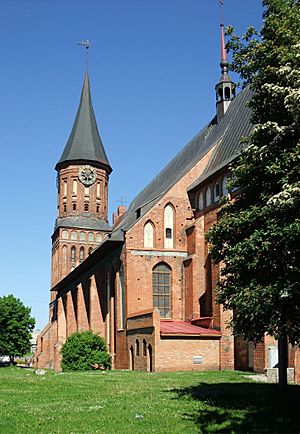Heinrich Albert (composer) facts for kids
Heinrich Albert (sometimes called Heinrich Alberti) was a German composer and poet who lived in the 1600s. He was born on June 28, 1604, and passed away on October 6, 1651. Albert was part of a group called the Königsberg Poetic Society. As a composer, especially of songs, he was greatly inspired by the famous musician Heinrich Schütz.
Contents
Heinrich Albert's Life Story
Albert was born in a town called Bad Lobenstein in Thuringia, Germany. From 1619 to 1621, he went to grammar school in Gera. In 1622, he started studying music in Dresden with his cousin, Heinrich Schütz. Schütz taught him the basic rules of composing music.
His parents wanted him to study law. So, in 1623, Albert enrolled at the University of Leipzig. But he kept studying music there too. He probably learned from Johann Hermann Schein, who was a friend of Schütz. Schein was a church music director, known as a Thomaskantor, in Leipzig.
Escaping War and Becoming an Organist
In 1626, Albert tried to avoid the Thirty Years' War. This was a big conflict happening in Europe at the time. He moved to Königsberg. The next year, he traveled from Königsberg to Warsaw as part of a group from the Netherlands. But Swedish soldiers captured him.
He was set free in 1628 and went back to Königsberg. There, he started studying how to build defenses for cities. By 1630, he was back to being a musician in Königsberg. On April 1, 1631, he became the organist at the Königsberg Cathedral. He worked there until he died at age 47. The university held his funeral. A Latin message written then is still our main source of information about his life.
The Königsberg Poetic Society
Albert was a member of the Königsberg Poetic Society. This group included other poets like Simon Dach and Martin Opitz. The poets often met at a special place in Albert's garden. It was an arbor, which is like a leafy shelter, called the Kürbishütte. This name means "Pumpkin Hut."
The city council of Knipawa had given Albert this garden in 1630. In his garden, Albert grew pumpkins and gourds. His friends would carve their fun, country-style nicknames into the gourds. Martin Opitz visited his friend Simon Dach there in 1638. Sadly, the garden and the arbor were later removed to make way for new houses.
Today, there is a memorial stone for Albert in a small group of trees in Bad Lobenstein.
Heinrich Albert's Musical Works
In Königsberg, Albert wrote music for both the city and the university. He composed music for many university events. One example is the 100th birthday celebration of the University of Königsberg in 1644.
Many of his "occasional compositions" still exist. These were pieces written for special events like weddings and funerals. He also wrote songs praising important people. Other songs were about nature, wine, and love. His most famous song is probably Ännchen von Tharau. The words for this song were written by Dach. Today, people usually sing this song to a different tune by Friedrich Silcher. Some of Albert's religious songs are still in German Protestant hymnals. These include Gott des Himmels und der Erden and Ich bin ja, Herr, in deiner Macht.
In 1643, Albert reconnected with Heinrich Schütz. He also studied with Johann Stobäus, who was the music director for the cathedral and court. Stobäus was part of the Königsberg school of composers. This group included musicians from Johannes Eccard to Johann Sebastiani.
Composers at that time often wrote music for five different parts or voices. Albert followed this rule too. Many of Albert's five-part songs were actually longer versions of his solo songs. He became very popular because of these solo songs, which often used a special type of bass line called "thorough-bass."
Publishing His Music
Albert wrote music for his own poems and those of his friends. He then published these as musical scores in eight books. Starting in 1638, these books were mostly called Arien oder Melodeyen. In total, they contained 170 songs.
He included introductions in these books. They gave detailed instructions on how to perform the music. For example, he said that one should not play the "continuo" (a type of accompaniment) "like hacking a cabbage." Besides these eight books, he published many other pieces for special occasions. Not all of these have been fully listed yet.
Albert was very protective of his music. He tried to stop others from printing his compositions without permission. He got special rights from the Duke of Prussia and the Polish king to protect his work. However, there was a pirated version of his Arien published in 1648. It was called Poetisch-musikalische Lustwäldlein. This version had parts 1 to 6 of his Arien but in a different order and with many mistakes.
Musical Style
Albert's tunes showed influences from different places. They had a French influence, carefully matching the stresses and lengths of words. They also had an Italian influence, showing feelings through music. For example, he used melisma (singing many notes on one syllable) and coloratura (fancy, fast notes) to express strong emotions. Albert also used many dance rhythms from Italy, Germany, and especially Poland.
Some of his songs were more complex than simple tunes. They were structured like cantatas. These pieces would have an instrumental introduction, lyrics, and a solo voice part that changed with the words. They would often end with a short part for a choir or instruments.
See also
 In Spanish: Heinrich Albert para niños
In Spanish: Heinrich Albert para niños



